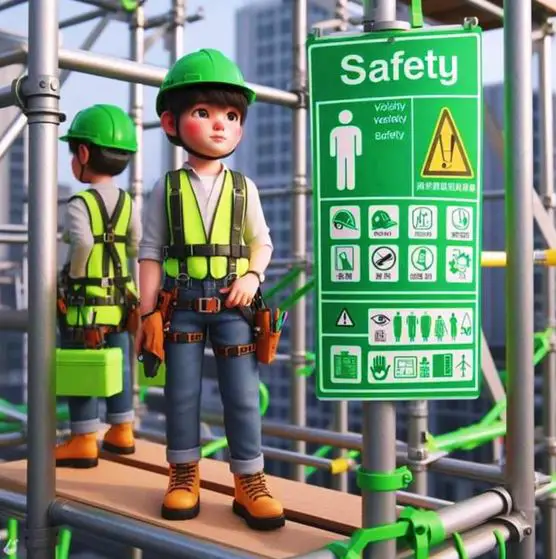Construction sites are always bustling with activity as hundreds of employees work round the clock to give architectural dreams a shape and form. But behind the din of machinery and buzz of construction, there is a very stark reality: construction reigns as one of the most dangerous industries for workplace accidents, injuries, and deaths.
The Occupational Safety and Health Administration (OSHA) shows construction accounts for a significant portion of occupational fatalities yearly, with falls, electrocutions, and struck by objects being among the leading causes. Thus, ensuring construction worker safety isn’t just a moral imperative, but a legal requirement avoiding costly legal issues, protecting human lives, and the reputation of construction companies.
Here are the six (6) legal tips to follow when working on-site.
- Obtain the Necessary Permits and Licenses
A critical step is getting the necessary permits and licenses before starting any construction project. This involves getting the right paperwork with legal authorizations from relevant authorities, as well as confirmation about the project’s compliance with local regulation standards.
However, failure to acquire permits has really bad legal implications, such as hefty fines, project shutdown, and serious legal action. The required types of permits will range from zoning regulations and building codes to environmental protection protocols, depending on the nature and scope of the project in question.
- Comply with OSHA Regulations
OSHA ensures employees’ work environments are safe and healthful through the definition of rules and directions that are in line with many different industries, including construction sites. These policies aim at lessening dangers, stopping harm, and ensuring the well-being of the workers. Ideally, the OSHA regulations provide the basis for:
Legal Obligations and Worker Protection
Complying with OSHA requirements is not just about meeting legal obligations but also about giving the construction worker top consideration for his safety and health. Complying ensures that employers clearly demonstrate strong commitments to providing safe working environments.
Importance of Proper Safety Protocols
Having proper safety protocols under OSHA compliance means spotting the prospective hazards at a construction site, evaluating potential risks, and finding proper ways to control and mitigate those risks. It should cover broader areas for safety protocols, including operating equipment, handling hazardous material, and emergency response procedures.
Key Components of OSHA Compliance
Safety and health, according to OSHA rules, need to be approached with much detail. For example, constant checking helps in the determination of potential risks. Besides, all the workers should be provided with training and a complete set of means of safety needed to carry out the hazards. Moreover, the employer must make records of training, inspections, and incidents to display compliance with OSHA regulations.
- Maintain Proper Documentation
Maintaining proper documentation proves vital for construction firms to show compliance with safety rules, conduct thorough inspections, and tackle any incidents or disputes occurring on-site properly. Furthermore, precise paperwork is a vital instrument defending corporate measures during court cases; thus, it is pivotal in lessening legal dangers. To ensure compliance and mitigate these risks, employers should establish clear procedures for documenting various safety measures, and any other relevant documentation pertaining to safety protocols and regulatory requirements.
In the unfortunate event of an injury due to negligence or unsafe working conditions, seeking legal counsel from experienced personal injury lawyers is essential. According to the legal team at Prochaska, Howell & Prochaska, experienced lawyers can help injured workers navigate the legal complexities and pursue rightful compensation. They will also ensure fair settlements on behalf of the injured party through negotiation and gathering essential evidence to build a strong case.
- Implement Proper Safety Training Programs
Comprehensive training prepares workers with all the knowledge that they are supposed to have, in addition to the skills necessary to undertake jobs in ways that are safe and minimize risks of accidents and injuries. Thus, the lack of proper training endangers the workers and may place construction companies at risk of legal liability. Employers are to design and develop sound safety training programs, which must be custom-built and in line with the prevailing hazards on site.
For employers to develop good safety training programs, identifying the unique risks workers may face is vital. Conducting thorough assessments and understanding construction regulations is essential. Furthermore, the content should cover those risks like fall protection, equipment use, and emergency plans.
Implementation Strategies
Planning safety training programs needs thoughtful preparation and execution. Firms should schedule frequent training sessions to ensure all workers get proper instruction. Skilled trainers ought to be hired to deliver training, providing hands-on demonstrations and applied guidance.
Ongoing Evaluation and Improvement
Safety training programs require ongoing appraisal and enhancement. This involves getting worker feedback to gauge training effectiveness and pinpoint improvement areas. Training programs should be revised as required to tackle any shortcomings or emerging risks. Furthermore, through commitment to continual learning and progress, employers can ensure their safety training programs stay effective and relevant over time.
Importance of Comprehensive Safety Training
Comprehensive safety training is vital for several reasons. For instance, it:
- Ensures workers are competent and prepared to handle the challenges and hazards that come with the job.
- It helps in safeguarding against injuries, creating a safer workplace for everyone.
- It helps avoid legal implications associated with inadequate training.
- Ensure Compliance with Building Codes and Regulations
Construction projects must follow building rules. These regulations set standards for materials, designs, and construction methods. In addition, they protect people inside and outside the buildings. However, not following the rules can lead to fines, delays, or stopping work. So, construction companies need to know the latest codes for their projects. They must plan and build with these rules from the start, as it prevents legal issues and promotes safety during construction.
- Establish Clear Contracts and Agreements
Putting clear contracts, agreements, and deals in writing is key for building projects. These papers show who does what, when, and how. Furthermore, they map out the plan, due dates, pay terms, and safety rules. Clear papers also help prevent mix-ups by giving guidance and settling disputes. Hence, by stating everyone’s jobs and rights, builders avoid legal issues, facilitating work to move on smoothly. Plus, open deals build trust among team members, contributing to the overall success of the projects.
Keeping sites safe matters for workers, passersby, and the environment – legally and ethically. Following the law, training workers, keeping records, and signing clear contracts creates safer places. In addition, firms reduce risks to workers and legal troubles. Caring about safety helps workers and projects as it shows the field acts properly. Moreover, it fosters a culture of responsibility and benefits all involved, thus boosting the image of construction.










